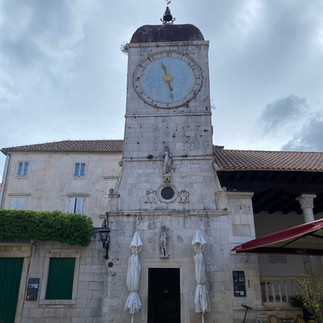TREASURES OF CROATIA(HOSTED PRIVATE SMALL GROUP TOUR- MAY 2023, 9 days)
- Debbie Rogers

- Oct 17, 2023
- 7 min read
Tips and Hints for Croatia
Effective Jan 1st, 2023 Euro is the official currency
Leave enough time for travel and exploring time in each location. We had to cut a few things out or we would have spent more time in the van than in places!
If you stay in any of the Old Towns, generally no vehicles are allowed, and you might have to carry/roll your own luggage. Some hotels are contracted with 3rd party porters who will assist you. Confirm if the hotel or YOU are paying the fee!
DO NOT USE the ATMs to exchange cash. Use currency exchange places further away from the tourist sites. Your guides or the concierge should be able to help you.
Make sure to sample the delicious alcoholic beverages showcasing lavender and cherries the flavors of the region as well as delicious olive oil. Many in the group (including myself) brought back home, wines, liqueurs, and olive oil to enjoy!
Day 1: Arrival in Zagreb
We arrived in Zagreb, Croatia's captivating capital city. Zagreb is an enchanting blend of old-world charm and vibrant urban energy. We were very centrally located at the Hotel Dubrovnik.
For those of us who arrived earlier in the day, we got a chance to explore a bit locally on our own and have dinner at an amazing (very reasonable) Michelin restaurant not far from our hotel.
Day 2: Private tour of Zagreb and rest of day at leisure
We were met at the hotel by our private guide, and we headed out. Some highlights on our private tour of Zagreb Cathedral and St. Mark's Church. Unfortunately, the Cathedral was undergoing repairs, so we weren’t able to go inside. In Lower Town, we experienced the modern side of Zagreb with its bustling Ban Jelačić Square and the Croatian National Theatre. Don’t miss the beautiful and vibrant flower market a highlight of Zagreb.
Day 3: Departure to Rijeka/Opatija -Exploring Istrian Peninsula
We first headed for a visit to the 2000-year-old Roman Colosseum located in Pula. The city was founded by an ancient tribe in the 10th century B.C. it was well-known by Greek travelers and sailors and is mentioned in many Greek myths. In the 1st century, the Romans made the city strong and today the vivid remains of this era can be explored. Pula Arena is one of the best-preserved amphitheaters in the world and will take you back in time as you imagine gladiator battles. After walking around and a stop for lunch we headed back out to Rovinj.
Rovinj. This city was also founded by the Istrian tribes. It was built on a small island close to the mainland and in the 18th was connected to it. It was ruled for five centuries by Venice so both the Italian and Croatian languages are spoken in the city. During this period of occupation, walls were built around the city and the remains are standing still today. Rovinj, a picturesque coastal town in Croatia, is home to several enchanting sights that showcase its rich history, natural beauty, and cultural charm. These were the the main sights we explore in Rovinj with our guide:
St. Euphemia's Church: This stunning Baroque church is the focal point of Rovinj's skyline. Climb the bell tower for panoramic views of the town and the Adriatic Sea. Warning: It is a steep uphill climb.
Balbi's Arch: This monumental arch is the entrance to the Old Town and serves as a reminder of Rovinj's history. Walk through the arch and immerse yourself in the Old Town's historical ambiance.
Grisia Street: Experience the vibrant art scene of Rovinj on Grisia Street. This picturesque street is lined with art galleries showcasing the works of local artists, creating a lively and creative atmosphere.
A few of us opted not to walk up to the church and instead took advantage of the beautiful weather and views to enjoy a beverage and relax.
After a full day of traveling and sightseeing, we arrived at our hotel for the night in Rijeka. While the views were spectacular, the beds weren’t the most comfortable, and the food/dining experiences weren’t the best.
Day 4: Plitvice Lakes National Park
Today we visited Plitvice Lakes National Park. It is a UNESCO World Heritage site and one of the oldest national parks in Southeast Europe. Known for its breathtaking beauty, the park is renowned for its cascading waterfalls, crystal-clear turquoise lakes, and lush, green landscapes. With 16 terraced lakes interlinked by a series of cascades and waterfalls, it's a paradise for nature lovers.
Visitors can explore the park through a network of wooden walkways and hiking trails that wind their way around the lakes, offering stunning views at every turn. Make sure you have the proper footwear as most areas are quite wet and slippery. Also, be prepared for quite a lot of walking/hiking-type activity. This was about a 90-minute experience, and unfortunately in the rain, but it’s a MUST DO if you are able to, when visiting Croatia.
We were ready for our hotel and some wine and dinner after this in our next destination of Zadar. We stayed at Hotel Teatro Verdi which was a cute centrally located hotel with a rich history.
https://teatro-verdi.book.rentl.io/?from=17-10-2023&to=19-10-2023&adults=1&children=&rooms=1
Dinner was at a nearby restaurant recommended by the hotel, and it was delicious. This was where I was introduced to a cherry liqueur, and this is a must-try when in Croatia!
https://konoba-martinac.hr/
Day 5: Zadar
Our private guide met us at our hotel for our 2-hour walking city tour in Zadar. Zadar is the heart of the Croatian Adriatic, rich in touristic attractions. During its existence, Zadar was for many centuries the home of the Liburni and was the capital city of Dalmatia for 1000 years.
We got the chance to explore St. Anastasia's Cathedral, Sea Organ, and Greeting to the Sun. Your guide also takes you inside the St. Donatus Church - the symbol of the city founded in the 9th century.
Note: the Sea Organ and Greeting to the Sun are very unique and NOT to be missed! We missed the latter because it started raining in the evening.
We finished our tour in the middle of Old Town and had lunch at one of the many cute restaurants there. After lunch, we all branched out to do more sightseeing and shopping 😊.
We had dinner again at a nearby restaurant. The food was good, but we preferred the food the previous night.
Day 6: Trogir
The next day we headed to Trogir. We were met by our private guide at our drop-off point for our 2-hour tour. Trogir is a charming coastal town in Croatia, known for its well-preserved medieval architecture and rich history. Its rich culture was created under the influence of old Greeks, Romans, and Venetians. With the high concentration of palaces, churches, and towers, as well as fortresses on a small island, Trogir is sometimes referred to as the floating museum town.
Located on a small island, connected to the mainland by a bridge, Trogir offers a unique blend of cultural heritage and picturesque surroundings. Explore the narrow cobblestone streets and visit the impressive Trogir Cathedral, a UNESCO World Heritage site, and don’t miss the Dalmation Klapa singers!
Klapa singing is a multipart singing tradition of the southern Croatian regions of Dalmatia. Multipart singing, a capella homophonic singing, oral tradition, and simple music-making are its main features. The leader of each singing group is the first tenor, followed by several tenori, baritoni, and basi voices.
After lunch and some exploring, we headed back to our van to head over to Split. The rest of the evening was exploring on your own and dinner at a very modern, popular restaurant. The ambiance was great, food was just ok.
Also, quick tip, an easy way to get to the middle of Old Town rather than going around is through the underground market. We found this out the 2nd day lol, but it was very helpful in avoiding the rain getting back to our van!
Day 6: Split
We stayed at Hotel Jupiter in Old Town.
Note that there is a very small elevator, and most rooms are a split level, so you might have to take your bags up a flight of stairs. You can ask the front desk for assistance, but depending on the staff, you might be on your own.
https://www.lhjupiter.com/
We woke up to pouring rain in Split. While we had a private tour scheduled in Split, we had to unfortunately forego it for safety reasons. Split is one of the most popular tourist destinations when visiting Split. There are many cruise ships arriving here making it very busy, touristy, and expensive! We found Split to be one of the most expensive towns and for most of the group, least favorite.
Highlights of the City include the 1700-year-old Diocletian Palace, the Cathedral of St. Duje, also called Saint Domnius, and its Temple of Jupiter, one of the most beautiful cultural wonders on the Adriatic coast.
You can also visit the ancient cellars, see Peristyle in the center of the palace, Roman temples, the famous Golden Gate, and the big statue of Grgur Ninski.
Day 7: Travel to Dubrovnik with wine tasting stop in Ston
The long ride from Split to Dubrovnik was broken up by stopping in Ston at a lovely little winery where we got to sample and buy wines, olive oil, and local cheeses! (yummy!)
Ston, a small town on the Peljesac Peninsula in Croatia, is steeped in history and natural beauty. Its impressive defensive walls, known as the "European Walls of China," offer stunning views of the surrounding countryside and the Adriatic Sea. The charming streets, historical buildings, and stone houses provide a glimpse into the region's medieval past. Ston is renowned for its oyster farms and is considered the oyster capital of Croatia, allowing visitors to experience fresh and delicious seafood. The nearby Mali Ston Bay offers a peaceful retreat with salt flats and picturesque coastlines perfect for boat rides and kayaking.
After a leisurely visit, we set out for Dubrovnik. We had dinner at a beautiful restaurant on the waterfront, and celebrated one of our traveler's birthdays with cake!
Day 8: Dubrovnik City Tour
Our tour guide met us at our hotel for our 2-hour tour of Old Town. Dubrovnik, one of the most popular and beautiful medieval cities on the Mediterranean, was included on UNESCO's World Cultural Heritage List for its well-preserved beautiful Gothic, Renaissance, and Baroque churches, monasteries, palaces, and fountains. Some of the most important sights: Onofrio's Fountains, Sponza Palace, Orlando's Column, City Bell Tower, Church of St Blaise, who is the city's patron saint, and many others. Not to be missed is a visit to the Franciscan Monastery and Rector's palace.
For Game of Thrones fans, Dubrovnik served as the perfect backdrop for the fictional city of King's Landing. Some of the Game of Thrones filming locations included. The Pile Gate, was used as the entrance to King's Landing, while the historic Rector's Palace transformed into the grandiose residence of the show's rulers.
We spent the rest of the day exploring the various cobblestone streets, shopping, and enjoying lunch and dinner with magnificent views!
Day 9: Departure Day









































































































Comments